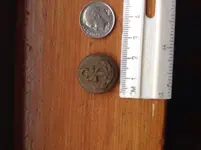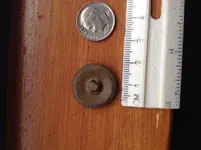You are using an out of date browser. It may not display this or other websites correctly.
You should upgrade or use an alternative browser.
You should upgrade or use an alternative browser.
Button ID Help
- Thread starter kano
- Start date
Dug
Bronze Member
- Joined
- Feb 18, 2013
- Messages
- 1,138
- Reaction score
- 1,264
- Golden Thread
- 0
- Location
- SC Lowcountry
- Detector(s) used
- XP Deus/Sovereign GT.
- Primary Interest:
- Relic Hunting
Civilian blazer button. The back is the give away.
Upvote
0
TheCannonballGuy
Gold Member
- Joined
- Feb 24, 2006
- Messages
- 6,606
- Reaction score
- 13,450
- Golden Thread
- 0
- Location
- Occupied CSA (Richmond VA)
- Detector(s) used
- White's 6000, Nautilus DMC-1, Minelab
- Primary Interest:
- Relic Hunting
Kano, at 13 posts, it seems you are still kinda new here, so I'll add some more-specific relic-ID info onto what Dug (correctly) told you.
A major method for accurately time-dating a metal button is to closely examine not only its "emblem" but also its metal type (brass, copper, pewter, etc.) and especially its "construction type." The charts below show the primary construction-types.
The key time-dating clue for your button, more important than anything else about it, is that its construction uses what button-collectors call a "self-shank back." That means:
Instead of having a separately-made wire loop or shank or other device for attaching the button to cloth, your 2-piece sheetbrass button's back ITSELF forms the hole/tunnel for the thread to attach the button to cloth. That's where the term "self-shank back" comes from.
There are several forms of self-shank back. The version on your button is what some button-collectors call a "pierced dome." The button's thin sheetbrass back has a distinct raised dome at its center, and the dome is simply pierced to create holes for the thread to pass through. Because this form is far simpler and cheaper to manufacture, it is very commonly used on cheap civilian-usage metal buttons. I should mention, insofar as I'm aware, it has never been used for Military buttons, because the crudely pierced holes in the metal back have sharp edges (instead of being rounded-off), which tends to cut through the attaching thread fairly quickly with daily use. You can see the crude hole's sharp edges in the final photo below.
This particular form of self-shank back was invented and US-patented in the very-early 1900s. (I saw the US Patent drawing of it long ago, but I can no longer recall the Patent-issue year, just approximately 1910 or so.) Thus, this version of self-shank back tells us your button is Civilian-usage, despite the Naval Anchor on its front, and it cannot date any earlier than approximately 1910.
A major method for accurately time-dating a metal button is to closely examine not only its "emblem" but also its metal type (brass, copper, pewter, etc.) and especially its "construction type." The charts below show the primary construction-types.
The key time-dating clue for your button, more important than anything else about it, is that its construction uses what button-collectors call a "self-shank back." That means:
Instead of having a separately-made wire loop or shank or other device for attaching the button to cloth, your 2-piece sheetbrass button's back ITSELF forms the hole/tunnel for the thread to attach the button to cloth. That's where the term "self-shank back" comes from.
There are several forms of self-shank back. The version on your button is what some button-collectors call a "pierced dome." The button's thin sheetbrass back has a distinct raised dome at its center, and the dome is simply pierced to create holes for the thread to pass through. Because this form is far simpler and cheaper to manufacture, it is very commonly used on cheap civilian-usage metal buttons. I should mention, insofar as I'm aware, it has never been used for Military buttons, because the crudely pierced holes in the metal back have sharp edges (instead of being rounded-off), which tends to cut through the attaching thread fairly quickly with daily use. You can see the crude hole's sharp edges in the final photo below.
This particular form of self-shank back was invented and US-patented in the very-early 1900s. (I saw the US Patent drawing of it long ago, but I can no longer recall the Patent-issue year, just approximately 1910 or so.) Thus, this version of self-shank back tells us your button is Civilian-usage, despite the Naval Anchor on its front, and it cannot date any earlier than approximately 1910.
Attachments
-
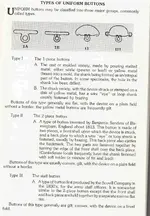 Buttons_TYPES_1piece-2piece-3piece_Albert-book)TN.webp197 KB · Views: 49
Buttons_TYPES_1piece-2piece-3piece_Albert-book)TN.webp197 KB · Views: 49 -
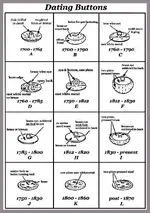 buttons_types_dating_TN_postedbyVPNavy_buttons_01.webp46.5 KB · Views: 51
buttons_types_dating_TN_postedbyVPNavy_buttons_01.webp46.5 KB · Views: 51 -
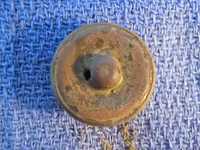 button_self-shank_USOfficer1832-1902_false3piece_backview_TN_photobyMcogan-LIMongoMike_IMG_3675.webp757.7 KB · Views: 48
button_self-shank_USOfficer1832-1902_false3piece_backview_TN_photobyMcogan-LIMongoMike_IMG_3675.webp757.7 KB · Views: 48 -
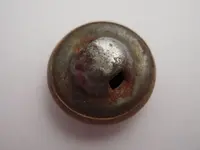 button_self-shank-back_false-3piece_1832-1902-eagle_ironback_backview_Ebay (2).webp14.2 KB · Views: 41
button_self-shank-back_false-3piece_1832-1902-eagle_ironback_backview_Ebay (2).webp14.2 KB · Views: 41
Last edited:
Upvote
1
Similar threads
- Replies
- 6
- Views
- 770
- Replies
- 2
- Views
- 247
Users who are viewing this thread
Total: 1 (members: 0, guests: 1)

